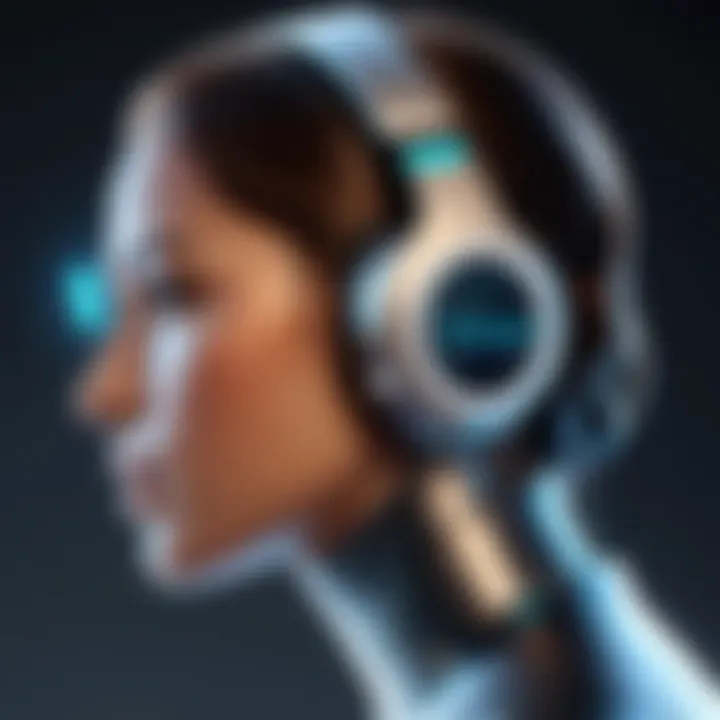Exploring Real Voice Changers: Tech and Uses


Intro
In today’s digital landscape, the ability to manipulate one’s voice is not just a fantasy; it’s become a practical tool across various domains. Voice changers tap into the intricate realm of sound technology, allowing users to modify their voice in real-time. This exploration goes beyond the mere gimmick of altering pitches; it dives into the underlying technology, diverse applications, and the various facets that make voice changers a compelling subject of study.
With the advent of streaming platforms, gaming, and more, real voice changers have found their way into mainstream use. Whether it’s someone looking to comedic effect in an online game, a content creator adding flair to a video, or a professional seeking to protect their identity, these tools serve a multiplicity of functions. Yet, as with any technology, there are ethical implications that users must navigate.
Understanding the nuances that come with real voice changers can provide profound insights into not just their functionality, but also their overall impact on communication in the digital era. This article aims to elucidate the key features of voice changers while diving into specific applications, ethical considerations, and potential future developments in this captivating field.
Intro to Real Voice Changers
Voice changers are fascinating tools that have become increasingly relevant in today’s digital landscape. The introductions of these devices and applications provide not only a means to transform one’s vocal identity but also serve various practical applications across multiple sectors. Understanding real voice changers is essential for anyone interested in technology, privacy concerns, or even the entertainment industry.
Defining Voice Changing Technology
Voice changing technology refers to the methods and tools used to modify a person’s voice. This can occur in real time or through pre-recorded audio; it usually involves altering certain characteristics like pitch, tone, modulation, and even the articulation of speech. With both hardware and software solutions available, users can explore many avenues for vocal manipulation. The digital realm allows for sophisticated processing, enabling users to make adjustments with relative ease. On the other hand, analog systems provide a more traditional approach, often cherished for their warm, rich tones that some purists prefer.
In technical terms, voice changers may use various algorithms and filters, including:
- Pitch Shifting: Adjusting the frequency of the sound wave to create a higher or lower voice.
- Formant Modification: Altering resonance frequencies that distinguish different vowel sounds.
- Effect Processing: Adding effects such as reverb, echo, or distortion to enhance user experience.
It’s worth noting that the applications are wide-ranging, from enhancing online gaming experiences to ensuring anonymity in conversations.
Historical Context of Voice Modification
Voice modification isn't a modern-day phenomenon. The seeds of voice changing technology can be traced back through time to various forms of artistic expression. Early voice modulation can be observed in theatrical performances, where actors used different techniques to convey a character’s emotions or backgrounds. As technology advanced, the introduction of analog synthesizers in the 1960s played a crucial role in voice modulation. Musicians exploring the boundaries of sound began experimenting with voice alterations to create unique auditory experiences.
Then, in the digital age, with the advent of computers and software development, voice changing technology saw a seismic shift. It transformed from complex hardware systems into accessible tools for everyday users. Now, almost anyone with a computer or smartphone can experiment with their voices, whether for personal enjoyment or for professional endeavors. This evolution reflects not just advances in technology but also a cultural shift towards privacy and individuality in the way we express ourselves vocally.
"The invention of technology has democratized voice changing; what was once confined to studios and stages is now at our fingertips."
In summary, the journey of voice changers from their rudimentary applications to sophisticated software illustrates the interplay of creativity and technology. Understanding this historical evolution offers vital context for anyone looking to grasp the full impact of these tools today.
Mechanisms of Voice Changers
Understanding the mechanisms behind voice changers is fundamental to appreciating how these technologies operate. They bridge the gap between simple voice modulation and complex audio manipulation, making it possible to transform a voice in numerous, often creative, ways. This section explores the core elements that make voice changers effective, emphasizing their importance in various applications ranging from entertainment to security.
Digital Signal Processing in Voice Changing
This area is where the magic happens. Digital signal processing (DSP) is the backbone of most modern voice changers. It involves analyzing and altering audio signals to achieve desired effects. DSP allows for manipulation of sound waves, enabling users to modify everything from pitch to timbre. Here are some key elements of this technology:
Filters and Effects
Filters are crucial in shaping audio. A filter modifies the frequency components of a sound, which allows the user to emphasize or de-emphasize certain characteristics of the voice. For instance, a low-pass filter might remove higher frequencies, creating a deeper sound that can be ideal for mimicking a different voice type.
Key Characteristics:
- Customizability: Many voice changers allow users to tweak filter parameters, leading to a bespoke effect that fits specific needs.
- Ease of Use: Filters can often be applied with simple controls, making them accessible even to novice users.
Unique Features:
- Innovative Effects: Some advanced filters can create complex audio effects, which are beneficial for audio production in entertainment industries.
Advantages/Disadvantages:
- Advantage: Filters can significantly enhance sound quality when used properly.
- Disadvantage: Overuse may lead to undesirable audio artifacts.
Pitch Shift Techniques
Pitch shifting alters the perceived frequency of a voice without changing its duration. This is particularly useful in applications requiring a distinct change to the vocal identity or tone. Users can shift pitch upwards for a childlike voice or downwards for a more robust sound.
Key Characteristics:
- Versatility: This technique finds a place in music production and gaming, allowing for immersion in varied auditory experiences.
Unique Features:
- Real-Time Processing: Many voice changers offer real-time pitch shifting, providing flexibility during live performances or interactions.


Advantages/Disadvantages:
- Advantage: Instant modifications help maintain user engagement and contribute to an enjoyable experience.
- Disadvantage: Extreme shifts may result in a robotic sound, which can detract from naturalness in some contexts.
Formant Alteration
Formants are the resonant frequencies of the vocal tract, significantly affecting how a voice is perceived. Altering these can change how natural or artificial a voice sounds post-processing. This technique is critically embraced in voice acting and dubbing, where mimicking a voice accurately is vital.
Key Characteristics:
- Naturalness: By focusing on formants, a voice changer can enhance realistic qualities, even with significant modifications.
Unique Features:
- Advanced Algorithms: Many modern systems use algorithms designed to preserve formant structures, making for a more believable output.
Advantages/Disadvantages:
- Advantage: This maintains the human-like qualities of a voice, which is crucial in creative industries.
- Disadvantage: Requires advanced technology, which may come at a higher cost.
Analog vs. Digital Voice Changers
The ongoing debate between analog and digital voice changers often highlights a preference based on context and end-use. Analog devices typically offer a warmer, more nuanced sound but can be less versatile than digital units. On the flip side, digital options provide exceptional flexibility, allowing users to apply multiple effects concurrently. Their ability to store settings and easily repeat them is a major advantage. However, the choice often boils down to personal preference, application needs, and budget constraints.
In summary, understanding the mechanisms behind voice changers helps users select the right tools and techniques to achieve their desired outcome, ensuring they can effectively shape audio experiences to meet diverse needs.
Types of Real Voice Changers
In the realm of voice manipulation, understanding the various types of voice changers is pivotal for both users and developers. These tools cater to a myriad of needs, spanning entertainment, privacy, and creativity. Choosing the right type not only enhances user experience but also aligns with specific purposes. Here, we'll dissect the prominent categories: software-based and hardware voice changers.
Software-Based Voice Changers
Software-based voice changers have gained considerable traction owing to their versatility and ease of access. Users can simply download an application or add an extension to their browser, making it an attractive solution for casual and professional use alike.
Application Software
Application software is among the most popular choices in voice modulation. This encompasses standalone programs that you can install on a computer or mobile device. Their primary strength lies in their customization capabilities. Users can tailor the output to suit personal styles, making them especially favored among gamers and content creators. A standout characteristic of these applications is their extensive effect library, which allows for a broad range of alterations—from pitch adjustments to the addition of sound effects like echoes or voice filters.
However, application software isn't without its downsides. Depending on system specifications, certain apps can be resource-intensive, which may impact overall performance. Additionally, there may be a learning curve associated with mastering more sophisticated features.
Browser Extensions
Browser extensions offer another layer of accessibility, allowing users to modify their voices during online interactions without the need for hefty installations. These extensions are usually light on resources and enable quick usage, making them ideal for casual chats, gaming sessions, or online streaming.
A defining trait of these extensions is their seamless integration with existing platforms, letting users apply voice changes as they engage in video calls or social media chats. However, the functionality might be limited compared to full-fledged software solutions. Many browser extensions focus primarily on straightforward features, which can deter those looking for deeper customization options.
Hardware Voice Changers
Competing with their software counterparts, hardware voice changers provide a tactile experience that many users still prefer. These devices often come with physical controls, giving a sense of control and immediacy that software sometimes lacks.
Standalone Devices
Standalone voice changers are robust solutions that operate independently of other hardware or software. They often feature knobs and sliders that allow users to manipulate pitch, modulation, and other aspects directly. This hands-on method appeals to audiophiles and professionals who require precise adjustments in real time. One of the main advantages of standalone devices is their superior audio quality compared to lightweight software applications, providing clearer and more nuanced output.
Nevertheless, the drawback lies in their bulkiness and potential cost. These devices can be significant investments and might not always be portable, which can be a consideration for users who travel or need mobility.
Integrated Technology in Gadgets
On the other hand, integrated technology in gadgets has emerged as a significant trend. Many modern devices, such as gaming consoles and smartphones, incorporate voice changing functionalities directly into their systems. This not only streamlines the user experience but also enhances accessibility for those who might be intimidated by standalone or software-based options.
The primary advantage here is convenience; users do not have to invest in additional hardware or software. However, these integrated solutions sometimes lack the advanced features found in dedicated products. Users might find that customization options are limited, which can affect their creative expression.
"The choice between software and hardware depends heavily on user needs—whether it’s the immediacy of a button or the finesse of a slider, there’s a solution that fits everyone."
In summary, both software-based and hardware voice changers present their unique advantages and disadvantages, appealing to different user bases. By distinguishing between the types, individuals can choose options that align closely with their intended usage.
Applications of Voice Changing Technology
The utilization of voice-changing technology spans various spheres, ranging from entertainment to privacy. Understanding these applications is critical as it highlights both the innovative uses and the boundary-pushing capabilities of voice changers. In today’s fast-paced digital world, where communication and content creation intertwine seamlessly, voice changers play a pivotal role, empowering users to explore new dimensions of creativity while also maintaining a level of anonymity, in turn raising some ethical questions.


Entertainment and Gaming Industry
Voice Acting and Dubbing
Voice acting and dubbing are pivotal in the realm of entertainment. These aspects breathe life into characters in animated films, video games, and other media. Using voice changers, voice actors can morph their vocal tone, pitch, and style, bringing characters to life in unique ways that enhance storytelling. For instance, in the animated series "The Simpsons," actors tweak their voices for different characters, making each one distinctive while adding depth and personality.
This technology allows for vivid expression and creative exploration. One significant advantage is the ability to produce a variety of voices without the need for individual actors for every unique character. That said, it does raise the question of how far one should go in modifying a voice—sometimes, overly manipulated voices can lose their natural quality, making it harder for audiences to connect emotionally with the characters.
Ultimately, the popularity of voice acting and dubbing using voice changers boils down to the notable effect they create; hence, they're a valuable tool in the industry.
Streaming and Content Creation
The rise of platforms like Twitch and YouTube has skyrocketed the relevance of voice changers for streamers and content creators. Many use these tools to add a unique twist to their streams, whether to entertain, safeguard privacy, or create a specific persona that distinguishes them in a crowded field. A popular choice among streamers includes the ability to switch voices mid-stream, catching viewers off guard and adding an unexpected layer of fun and interaction.
Moreover, the unique feature of faceless streaming, where voice changers help mask the streamer's real identity, is advantageous in fostering a sense of freedom. This anonymity can lead to candid and genuine interactions with viewers. However, there's a flip side—some audiences might consider this approach as deceptive, and shying away from transparent engagement can deter potential followers.
Despite varying opinions, streaming remains a hotbed for voice changing technology, proving its ability to invigorate content while providing opportunities for creative expression.
Communication and Privacy
Anonymous Interactions
In forums and chat rooms, anonymous interactions become a viable method for people to express themselves without the fear of judgement. Voice changers facilitate this, allowing users to engage in conversations under a disguise, thus creating a comfortable environment for individuals who may hesitate to speak freely in their authentic voice. A prime example is in gaming communities, where players often communicate via voice chat, using these tools to alter their tone, leading to a more inclusive atmosphere where everyone feels encouraged to share their thoughts and strategies.
However, the popularity stems partly from the potential risks—engaging in anonymous conversations can sometimes lead to harmful or inappropriate behavior. It's a double-edged sword; while anonymity can create openness, it can also catalyze negative interactions.
Protection from Voice Identification
Another crucial application of voice-changing technology is in protecting users from unwanted voice identification. This aspect is especially relevant in a world increasingly concerned with privacy and data security. Users can modify their voice to prevent voice recognition systems from tracking them, contributing to personal comfort in a landscape filled with surveillance and monitoring. For instance, activists may use voice changers to communicate securely without the risk of being identified.
While this provides a substantial advantage in safeguarding one's identity, there are pressing ethical considerations surrounding its potential misuse. For example, someone wishing to engage in harmful activities might exploit such technology to deceive others. Hence, although it carries benefits, it’s essential to reflect on the moral implications tied to using this technology.
In summary, the applications of voice-changing technology touch every corner of our cultural landscape—from entertainment and gaming contexts to communication and privacy realms. The duality of these benefits and drawbacks highlights the importance of understanding not just how these tools can be used creatively but also how they impact society at large.
Choosing a Real Voice Changer
Understanding how to choose a real voice changer is crucial for anyone interested in voice modification technology. Whether the aim is for casual fun, professional needs, or privacy concerns, a suitable voice changer can make all the difference. By evaluating key features, users can find a product that meets specific requirements, ensuring the best experience possible. The right choice can enhance creativity, improve communication, and even bolster security in digital interactions.
Key Features to Consider
Ease of Use
The ease of use of a voice changer often dictates how enjoyable and efficient the experience will be. A straightforward, intuitive interface allows users to dive right into modifying their voice without the frustration that often accompanies complex technology. For instance, a voice changer that offers one-click presets or simple sliders enables everyone, including non-techies, to get in on the action. This simplicity is a key characteristic because it minimizes the learning curve.
One unique aspect of ease of use is that many software-based solutions often feature drag-and-drop functionality, allowing users to quickly access and adjust their desired effects. The disadvantage, however, might arise when combining multiple effects, as sometimes this can complicate things if the software isn't intuitively designed.
Output Quality
When diving into voice changing, output quality stands as a cornerstone of any effective solution. A high-quality output ensures that the modified voice sounds natural, precise, and aesthetically pleasing, which is paramount whether for professional setups or casual use. The key characteristic here is fidelity—how well the voice retains its clarity and essence after modification.
An excellent voice changer might come equipped with advanced algorithms that maintain the nuances of natural speech. However, some products can introduce artifacts or distortions, particularly at extreme settings—this can lead to the voice sounding robotic or unconvincing, which can undermine the experience.
Customization Options
The horizon of customization options is vast and can significantly enhance user satisfaction. A capable voice changer allows individuals to modify their voice in a multitude of ways, from pitch and timbre to more intricate effects like modulation and echo. This key characteristic caters to creative minds seeking to experiment with their auditory persona.
One standout feature is the ability to save and load presets, enabling users to quickly switch between different voice profiles that suit various scenarios—like gaming, voiceovers, or simply fun conversations. On the downside, an overly complex customization menu might overwhelm new users and could potentially discourage exploration.
Comparative Analysis of Popular Products
Software Solutions
Software solutions for voice changing have gained immense popularity. They’re generally easily accessible and frequently updated, which is a beneficial aspect for tech enthusiasts. For example, programs like Voicemod provide a user-friendly interface and a variety of fun voices to choose from, which is ideal for casual use.
A unique feature of these solutions is their ability to integrate directly with streaming platforms, allowing for real-time voice changes during broadcasts. However, reliance on system resources can be a drawback, as lower-end computers might struggle with performance.
Hardware Devices


On the other hand, hardware voice changers present a different set of advantages. They are often seen as more professional tools, providing high-quality sound modification without putting additional strain on a computer system. Devices like the BOSS RV-6 pedal can offer incredible sound manipulation and effects directly at the source.
The key characteristic of these devices is their durability and reliability, making them a great option for performing artists and serious content creators. Conversely, the price point can be a roadblock for casual users, potentially leading to a smaller market share in comparison to software solutions.
Ethical Considerations and Implications
Understanding the ethical landscape surrounding voice changing technology is vital. As these tools become more accessible, they carry both the promise of creativity and the burden of potential misuse. Acknowledging these ethical implications helps in crafting guidelines that promote responsible use while also recognizing genuine concerns raised by their applications in society.
Potential for Misuse
Cyberbullying and Harassment
The ability to disguise one’s voice can be a double-edged sword, particularly when it comes to cyberbullying and harassment. The anonymity provided by voice changers can embolden individuals to engage in malicious behaviors. In this context, what’s worth noting is the sad reality that many feel more secure in attacking others behind a veil of altered identity; they think it’s less risky. This characteristic often makes voice changers attractive tools for those who wish to perpetrate harm without facing accountability.
The unique feature of these technologies is their capacity to craft a completely different persona in audio. This not only adds layers to the deception but also can create distress for victims. A person listening to an altered voice might find it more challenging to identify the source of harassment, amplifying feelings of fear and powerlessness.
The advantages of this anonymity can lead to increased harassment cases since it allows a perpetrator to evade direct confrontation. However, the disadvantages are significantly weighty, impacting mental health and trust within communities.
Fraudulent Activities
Fraudulent activities represent another core concern tied to voice changing technology. With the ability to imitate someone else’s voice, there exists a pathway for nefarious individuals to conduct scams that can wreak havoc on unsuspecting victims. This method can enable impersonation of business voices or loved ones for monetary gain, which is alarmingly effective. The key attribute in fraudulent uses is the sophisticated manipulation of voice, creating a semblance of authenticity that can mislead individuals.
Such activity not only threatens financial stability but also erodes trust among individuals, businesses, and institutions. A unique feature of these fraud scenarios is the integration of other technologies, such as AI, to modify voices in real time, making detection much harder.
Despite their potential, the disadvantages heavily skew against the misuse of voice changers. The emotional and financial repercussions of such fraud are far-reaching, often leading to legal and personal consequences for victims.
Regulatory Challenges
Given the context of these ethical concerns, there are significant regulatory challenges that need addressing. Policymakers grapple with the task of enforcing laws that adequately tackle the misuse of voice changing technology. Creating stringent guidelines is difficult because of gap in regulations that may vary across regions.
As voice changers integrate more deeply into communication ecosystems, the lack of standards complicates law enforcement efforts. Regulations need to not only cover the technology itself but also provide clear repercussions for its misuse. The ongoing cat-and-mouse game between technology advancements and regulators' ability to craft effective legislation represents a substantial hurdle.
In summary, context around the ethical use of voice changers informs many conversations we must have about the technology's role in society. With careful consideration, it’s about striking a balance between innovation and responsibility.
Future Trends in Voice Change Technology
The evolution of voice changing technology is accelerating at a remarkable pace, driven by advancements in artificial intelligence and shifting market demands. As society becomes increasingly reliant on digital communication, understanding these emerging trends is key for both consumers and industry professionals. This section sheds light on pivotal developments that are set to redefine how we perceive and utilize voice modulation in various fields.
Advancements in AI and Machine Learning
The integration of AI and machine learning into voice changing technology stands to enhance the accuracy and realism of voice manipulation significantly. In traditional voice changers, modifications often appear artificial or exaggerated. However, recent innovations aim to capture the nuanced characteristics of human speech. For instance, neural networks can analyze vast amounts of voice data, learning to mimic not only pitch but also emotion, tone, and accent.
Some companies are already implementing these technologies to create solutions tailored for users. For example:
- Deep Voice and similar projects utilize deep learning to synthesize voice with human-like qualities.
- Voice changers may soon be capable of real-time language translation, allowing users to communicate seamlessly across language barriers while maintaining their distinct intonations.
- AI could enable dynamic voice adaptation during conversations, altering tone based on inferred emotional context, effectively enhancing user engagement.
"The future of voice technology doesn't merely involve changing sounds. It’s about creating authentic experiences that resonate with users in ways we've yet to fully explore."
Impact on Various Industries
The ripple effect of advancements in voice changing technologies will span multiple industries. Each sector will leverage these tools in unique ways, influencing how we connect, entertain, and inform.
- Entertainment: Animation and gaming industries are already benefiting from tailored voice modifications, improving character portrayal in video games and films. Actors can utilize voice changers to lend their vocal identities to a broader range of characters, enhancing storytelling.
- Telecommunications: Businesses may incorporate voice modulation for call anonymity, a key consideration in sectors like telehealth or customer service. This ensures confidentiality while providing clients with the ease of voice interactions.
- Education: Language teachers might use advanced voice changers to demonstrate accents or dialects, offering students a more interactive learning experience that helps bridge cultural gaps.
- Content Creation: Influencers and streamers can adopt unique voice personas, tailoring their brand identity to attract and engage larger audiences. This could lead to more dynamic interactions on platforms like Twitch and YouTube.
As we stand on the brink of these advancements, it's clear that voice change technology is more than just a novelty—it has become a significant player in our daily lives and interactions. By keeping an eye on these future trends, we can adapt and fully harness their capabilities.
The End
In the landscape of modern communication, real voice changers hold a pivotal significance. They serve not just as tools for entertainment but also as vital instruments for anonymity and privacy. The importance of voice changers extends into various domains, from the creative arts to cybersecurity, showcasing their multifaceted utility. As we wrap up, let's delve deeper into some of these insights.
Summary of Insights
Throughout the article, we’ve explored the intricate mechanics, varied applications, and ethical ramifications of voice changing technology. Here are the key takeaways:
- Technology Foundation: Real voice changers utilize advancements in digital signal processing, enabling users to alter voice characteristics effectively. The distinction between analog and digital systems is noteworthy, influencing functionality and output quality.
- Application Spectrum: The versatility of voice changers is impressive. They find relevance in gaming, content creation, and even in private communications where anonymity is sought.
- Market Dynamics: With a plethora of options, selecting the right voice changer involves weighing features like ease of use, customization capabilities, and output clarity.
- Ethical Dimensions: It's crucial to address potential misuse in harmful contexts, highlighting the need for regulations while balancing innovation and creativity.
The Role of Real Voice Changers in Modern Society
Today, real voice changers are not merely novelties; they play significant roles across various societal facets. In the entertainment industry, these tools have transformed how voice actors perform, allowing them to create diverse character voices that add richness to narratives in films, games, and more. Furthermore, with the rise of streaming, many content creators now leverage these technologies to engage their audience with unique personas, thereby enriching their brand while maintaining a sense of privacy.
Additionally, voice changers empower users by providing a layer of security in communications, particularly in an era where digital footprints are easily traceable. The capability to modify one's voice encourages candid conversations, fostering creativity and openness in discussions that might otherwise be stifled by fear of identification.
"In a world dominated by sound bites and quick remarks, the ability to control one’s voice can fundamentally alter communication dynamics."
As technology continues to evolve, so too do the implications of voice-changing tools. With the continuous advancements in artificial intelligence and machine learning, it’s reasonable to expect even more sophisticated features in the future. This evolution poses exciting opportunities for creative exploration while simultaneously raising critical considerations regarding ethics and responsibility in their use. Clearly, the journey of real voice changers is just beginning.



